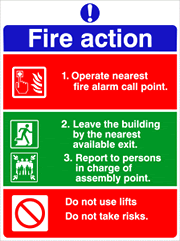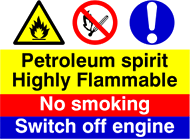FREQUENTLY ASKED QUESTIONS regarding Fire Safety Assessment
1. What Will Happen to Fire Certificates?
The introduction of the new Regulatory Reform (Fire Safety) Order 2005, has seen the repeal of the Fire Precautions Act 1971 and consequently the requirement for certification.
The new Order came into force in October 2006 and as such, existing fire certificates will cease to have effect from the effective date.
2. What is a Fire Risk Assessment?
The responsible person must carry out, or appoint a competent person to carry out a suitable and sufficient fire risk assessment of the risks of fire to their employees and others who may be affected by their work or business. Those who employ five or more employees should keep a formal record of any significant findings and remedial measures which have, or may need to be, taken.

3. What Firefighting Equipment do I need?
To enable the responsible person to make decisions as to what firefighting equipment is necessary access has been granted to the joint protocol between the Fire Extinguishing Trades Association, the Chief Fire Officers Association and the Local Government Association.
This protocol gives all the information necessary to make a reasonable assessment of the type and quantity of firefighting equipment needed.
4. How Can I Manage Fire Safety Responsibilities?
The management of fire safety in a building is a prime function of any manager. The terms manager or management should be taken to apply to the person who has overall control of the premises at any particular time whilst people are present.
A common cause of fatalities in fires is the failure of the occupants of buildings, whether staff or members of the public, to take the appropriate action when fire is discovered or the alarm is raised. Only effective management combined with appropriate staff training can ensure that the correct actions are likely to be taken and that occupants will be able to escape safely.
 Management needs to be aware of the statutory requirements regarding the maintenance of means of escape, fire warning arrangements, portable firefighting equipment, escape lighting, fire safety instructions to staff, etc.
Management needs to be aware of the statutory requirements regarding the maintenance of means of escape, fire warning arrangements, portable firefighting equipment, escape lighting, fire safety instructions to staff, etc.
Whatever the size of building there should be no doubt as to the person or persons with whom the responsibility lies. He or she needs to be fully aware of all the fire safety features provided in the premises and the reasons for their provision.
An essential part of the management’s duties in respect of fire safety is the training of staff. All staff, including part time members, cleaning staff and contractors need to be familiar with the actions to be taken in the event of fire, with how to call the fire and rescue service, basic fire prevention and with the exits and exit routes provided.
Fire safety training needs to be a continuous feature commencing on the first day of appointment of new staff and continuing in the form of regular refresher training. The training should based on written instructions appropriate to their specific responsibilities in the event of emergency and should be delivered by a competent person.
Staff with specific duties in the event of fire and staff having a supervisory role should receive additional training and detailed instruction in their own Fire Safety Training
5. What Fire Safety Training Should I Provide To My Staff?
It is the responsibility of employers to ensure that their staff are adequately trained on what to do in the event of fire.
Training should be should be given upon induction and preferably a second time within the first month of employment. Refresher training should be given at least once a year.
Training should be undertaken by a competent person and a record kept in some form of logbook. It can be carried out in house, or by a reputable company.
Fire instruction should be given to staff in respect of the following:-
 Discovering a fire
Discovering a fire- Hearing the fire alarm
- Assembly points
- Calling the Fire and Rescue Service
- Use of fire extinguishers
- Discovering a Fire
Personnel should be made aware of the method of raising the alarm in a premises, this should include the position of manual fire alarm call points and their method of operation.
Hearing the Fire Alarm
Personnel should be made aware of the evacuation procedures in their workplace. They should be shown escape routes and final exits, they should also be made aware of fire doors and their purpose in protecting escape routes.
Assembly Points
Personnel should be shown their ‘Fire Assembly Point’ and made aware of the need to ensure they have been accounted for.
Calling the Fire and Rescue Service
Personnel should be made aware of the method of calling the fire and rescue service and the location of telephones.
Use of Fire Extinguishers
Personnel should be trained in the safe use of fire extinguishers. It is not acceptable to say ’employees are not expected to use an extinguisher and therefore they don’t need to know’.
